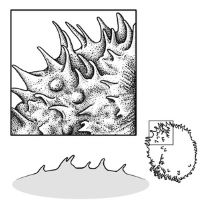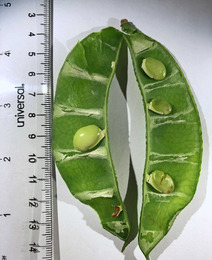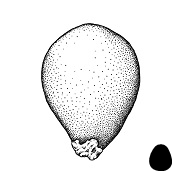Family Name: Bignoniaceae Jussieu
Synonym(s): Crescentiaceae Dumort.
Common Name(s): trumpet-creeper family
*Number of genera/species: 82/870
List of genera records in GRIN-Global
Fruit derived from a simple, superiorsuperior:
ovary not enclosed to any degree by a floral tube casing, the perianth and/or androecium thus arising beneath (proximal to) it
, 2-carpellate ovary. Fruit a loculicidalloculicidal:
type of capsular dehiscence, opening longitudinally through the locules (compare septicidal)
 or septicidalsepticidal:
or septicidalsepticidal:
type of capsular dehiscence, opening longitudinally by separating between the septa of adjacent carpels
 capsulecapsule:
capsulecapsule:
a dry, dehiscent fruit derived from a compound ovary , bilocularbilocular:
, bilocularbilocular:
(ovary or fruit) having two locules
, rarely appearing as 1 or 4-locular, dehiscing parallel or perpendicular to septumseptum:
(pl. septa) a dividing cross wall or partition
 , often with replumreplum:
, often with replumreplum:
the rim, formed by the persistent placentas, and connected by a false septum in Brassicaceae fruits. The fruit valves are attached to this rim and separate from it in dehiscent fruits.
, sometimes a berryberry:
an indehiscent, fleshy fruit with one or a few to many seeds. The flesh may be homogenous throughout. Or, if the outer part is hard, firm, or leathery, referred to as an hesperidium. Septa are present in some, and the seeds may be arillate or with a fleshy testa. or pepo, 3–100 cm, usually elongate and straight, sometimes curvedcurved:
or pepo, 3–100 cm, usually elongate and straight, sometimes curvedcurved:
(of embryo) linear embryo is curved into an arch or horseshoe with the ends far apart or twisted, tereteterete:
or twisted, tereteterete:
approximately circular in cross section; width and thickness approximately equal
 or strongly flattened in transection, rarely beakedbeak:
or strongly flattened in transection, rarely beakedbeak:
a usually firm, terminal appendage, sometimes tapered , calyxcalyx:
, calyxcalyx:
the outer whorl of the perianth; all the sepals of a flower sometimes persistent, with numerous seeds. Pericarppericarp:
sometimes persistent, with numerous seeds. Pericarppericarp:
fruit wall or fruit coat
gray, black, brown, reddish-brown, or green, sometimes with lightly-colored conspicuous lenticels, dull, woodywoody:
texture—consisting mainly of indurate lignified tissues, characteristic of or resembling wood
or leatheryleathery:
texture—moderately thick, tough, and very pliable
(capsulecapsule:
a dry, dehiscent fruit derived from a compound ovary ), fleshy or rarely fibrousfibrous:
), fleshy or rarely fibrousfibrous:
texture—long, flexible threads, thicker than hairs, that densely cover and obscure the surface with hard cortex (berryberry:
with hard cortex (berryberry:
an indehiscent, fleshy fruit with one or a few to many seeds. The flesh may be homogenous throughout. Or, if the outer part is hard, firm, or leathery, referred to as an hesperidium. Septa are present in some, and the seeds may be arillate or with a fleshy testa. ), or fleshy cortex and fibrousfibrous:
), or fleshy cortex and fibrousfibrous:
texture—long, flexible threads, thicker than hairs, that densely cover and obscure the surface core (pepo), glabrousglabrous:
core (pepo), glabrousglabrous:
without hairs
, pubescentpubescent:
surface relief—bearing hairs
, often lepidotelepidote:
bearing scales, scaly, squamate, squamose
, smooth, striatestriate:
surface relief—having fine, parallel lines, grooves or ridges , or longitudinally ribbedribbed:
, or longitudinally ribbedribbed:
surface relief—wide, prominent, linear ridges that are generally rounded and longitudinally situated on the surface , sometimes with spines (densely echinate, Tourrettia) or warts.
, sometimes with spines (densely echinate, Tourrettia) or warts.
Seeds usually flattened, ellipsoidellipsoid:
3D shape—elliptic
to bilobed, compressedcompressed:
flattened; in grasses, used to denote compression (not necessarily flattened) either laterally or dorsiventrally
to flattened in transection, 1–70 mm, including wing. Usually winged, sometimes wing reduced or absent (usually in indehiscentindehiscent:
not opening on its own, as in a fruit
 fruits). If winged, usually two-winged (bialate), sometimes ends or margins of wings fragmented and appearing fringed, sometimes one-winged and encompassing seed body, or rarely just apically winged. Wings hyaline-membranous or paperypapery:
fruits). If winged, usually two-winged (bialate), sometimes ends or margins of wings fragmented and appearing fringed, sometimes one-winged and encompassing seed body, or rarely just apically winged. Wings hyaline-membranous or paperypapery:
texture—papyraceous, chartaceous; very thin, pliable, and readily torn; like paper
, rarely corkycorky:
firm, relatively light, discontinuous but strongly cohesive, and resilient
. Ratio of seed body to wing variable. Seed coat black, brown, reddish, or white-transparent (Te comacoma:
a tuft of hairs, often attached to the tip of seeds
spp.), glabrousglabrous:
without hairs
or pubescentpubescent:
surface relief—bearing hairs
, smooth, rarely striatestriate:
surface relief—having fine, parallel lines, grooves or ridges or verrucoseverrucose:
or verrucoseverrucose:
surface relief—warty, covered with wart-like projections
.
Embryo well developed, partially filling seed cavity, foliatefoliate:
appearing leaf-like
, straight, with investinginvesting:
(of embryo) embryo is nearly or completely filling seed coat, straight, and axile and centric with spatulate cotyledons and covering the stalk for at least half its length; (of cotyledons) cotyledons spatulate and covering the stalk for at least half its length
cotyledons, usually thin with lobed apicesapex:
the point farthest from the point of attachment, or the "tip" of an organ .
.
Endosperm absent.
| Fruit | |
| Type | usually capsulecapsule: a dry, dehiscent fruit derived from a compound ovary  , sometimes berryberry: , sometimes berryberry:an indehiscent, fleshy fruit with one or a few to many seeds. The flesh may be homogenous throughout. Or, if the outer part is hard, firm, or leathery, referred to as an hesperidium. Septa are present in some, and the seeds may be arillate or with a fleshy testa.  or pepo or pepo |
| Size range | 3–100 cm long |
| Shape(s) | ellipsoidellipsoid: 3D shape—elliptic , fusiformfusiform: spindle-shaped; broadest at the middle and tapering at both ends  , linearlinear: , linearlinear:(shape) long, narrow, and uniform in width; (of embryo) embryo is straight and much longer than wide  , oblongoblong: , oblongoblong:2D shape—much longer than broad with nearly parallel sides, corners are rounded  , cylindricalcylindrical: , cylindricalcylindrical:3D shape—a cylinder, with parallel sides and a circular cross-section; tubular or rod-shaped , rarely sphericalspherical: 3D shape—globose or subtetragonal, sometimes stipitatestipitate: borne on a stalk ; usually straight, sometimes curvedcurved: (of embryo) linear embryo is curved into an arch or horseshoe with the ends far apart  to twisted to twisted |
| Texture | woodywoody: texture—consisting mainly of indurate lignified tissues, characteristic of or resembling wood , leatheryleathery: texture—moderately thick, tough, and very pliable , sometimes fleshy or fibrousfibrous: texture—long, flexible threads, thicker than hairs, that densely cover and obscure the surface  |
| Surface relief | smooth, striatestriate: surface relief—having fine, parallel lines, grooves or ridges  , longitudinally ribbedribbed: , longitudinally ribbedribbed:surface relief—wide, prominent, linear ridges that are generally rounded and longitudinally situated on the surface  , lenticellate, spinyspiny: , lenticellate, spinyspiny:having slender, stiff, sharp projections oriented in the general plane of the structure  , wartywarty: , wartywarty:surface relief—distinct, rounded projections that are large relative to the fruit size; tuberculate, verrucose  |
| Color(s) | gray, black, brown, reddish-brown, green |
| Unique features | Usually large, dulldull: reflecting only a low proportion of incident light, with no apparent sheen  , brown or black, elongate, bivalved capsulescapsule: , brown or black, elongate, bivalved capsulescapsule:a dry, dehiscent fruit derived from a compound ovary  with flat, winged seeds lacking endosperm. Fruits often appear like legumeslegume: with flat, winged seeds lacking endosperm. Fruits often appear like legumeslegume:a usually dry, dehiscent fruit derived from a single carpel that opens along two longitudinal sutures, derived from a single, superior, simple ovary  , except packed with winged seeds. Or, large berriesberry: , except packed with winged seeds. Or, large berriesberry:an indehiscent, fleshy fruit with one or a few to many seeds. The flesh may be homogenous throughout. Or, if the outer part is hard, firm, or leathery, referred to as an hesperidium. Septa are present in some, and the seeds may be arillate or with a fleshy testa.  or pepos with flattened, wingless seeds embedded in their pulp. or pepos with flattened, wingless seeds embedded in their pulp. |
| Seed | |
| Size range | 1–70 mm long |
| Shape(s) | usually flattened, ellipsoidellipsoid: 3D shape—elliptic , oblongoblong: 2D shape—much longer than broad with nearly parallel sides, corners are rounded  , obovateobovate: , obovateobovate:2D shape—ovate or egg-shaped in outline, with attachment at or near the narrow end (compare ovate, ovoid)  , bilobed, rarely roundround: , bilobed, rarely roundround:2D shape—orbiculate; circular  |
| Surface relief | smooth, rarely striatestriate: surface relief—having fine, parallel lines, grooves or ridges  or verrucoseverrucose: or verrucoseverrucose:surface relief—warty, covered with wart-like projections |
| Color(s) | black, brown, reddish, white-transparent |
| Unique features | Usually flattened, two-winged seeds lacking endosperm. |
| Other | |
| Embryo | well developed, partially filling seed cavity, foliatefoliate: appearing leaf-like , straight, with investinginvesting: (of embryo) embryo is nearly or completely filling seed coat, straight, and axile and centric with spatulate cotyledons and covering the stalk for at least half its length; (of cotyledons) cotyledons spatulate and covering the stalk for at least half its length cotyledons, usually thin with lobed apicesapex: the point farthest from the point of attachment, or the "tip" of an organ  |
| Nutritive tissue | endosperm absent |

Distribution map courtesy of Angiosperm Phylogeny Website.
Acevedo-Rodríguez et al. 2015 onwardsAcevedo-Rodríguez et al. 2015 onwards:
Acevedo-Rodríguez P et al. 2015 onwards. Lianas and climbing plants of the Neotropics. URL: https://naturalhistory.si.edu/research/botany/research/lianas-and-climbing-plants-neotropics; Flora of Australia 2021+Flora of Australia 2021+:
Flora of Australia. Australian Biological Resources Study, Canberra. Accessed January 2021–March 2024. URL: http://www.ausflora.org.au; Gentry 1992Gentry 1992:
Gentry AH. 1992. Bignoniaceae: Part II (Tribe Tecomeae). Flora Neotropica 25(2): 1–370. http://www.jstor.org/stable/4393739; Gentry 1980Gentry 1980:
Gentry AH. 1980. Bignoniaceae: Part I (Crescentieae and Tourrettieae). Flora Neotropica 25(1): 1–130. http://www.jstor.org/stable/4393736; Kirkbride et al. 2006Kirkbride et al. 2006:
Kirkbride JH, Jr, Gunn CR, and Dallwitz MJ. 2006. Family guide for fruits and seeds, vers. 1.0. Accessed September 2020-January 2022. URL: https://nt.ars-grin.gov/seedsfruits/keys/frsdfam/index.cfm .; Kubitzki et al. 1990+Kubitzki et al. 1990+:
Kubitzki K et al., eds. 1990+. The families and genera of vascular plants. 7+ vols. Berlin etc.; Manning 2000Manning 2000:
Manning SD. 2000. The genera of Bignoniaceae in the southeastern United States. Harvard Papers in Botany 5(1): 1–77. http://www.jstor.org/stable/41761593; Takhtajan 2009Takhtajan 2009:
Takhtajan A. 2009. Flowering plants: Second edition. Springer Nature, Switzerland. 871 pp.; Zhengyi et al. 2004+Zhengyi et al. 2004+:
Zhengyi W, Raven PH, and Deyuan H. 2004+. Flora of China [online]. 25 vols. Science Press, Beijing China & Missouri Botanical Garden, St. Louis USA. Accessed January–March 2024. http://flora.huh.harvard.edu/china/
*The number of genera and species is based on Christenhusz and Byng 2016Christenhusz and Byng 2016:
Christenhusz MJM and Byng JW. 2016. The number of known plant species in the world and its annual increase. Phytotaxa 261 (3): 201-217. https://doi.org/10.11646/phytotaxa.261.3.1, which may differ from the number of genera in GRIN-Global.